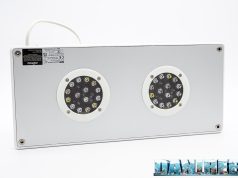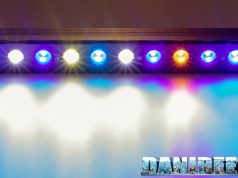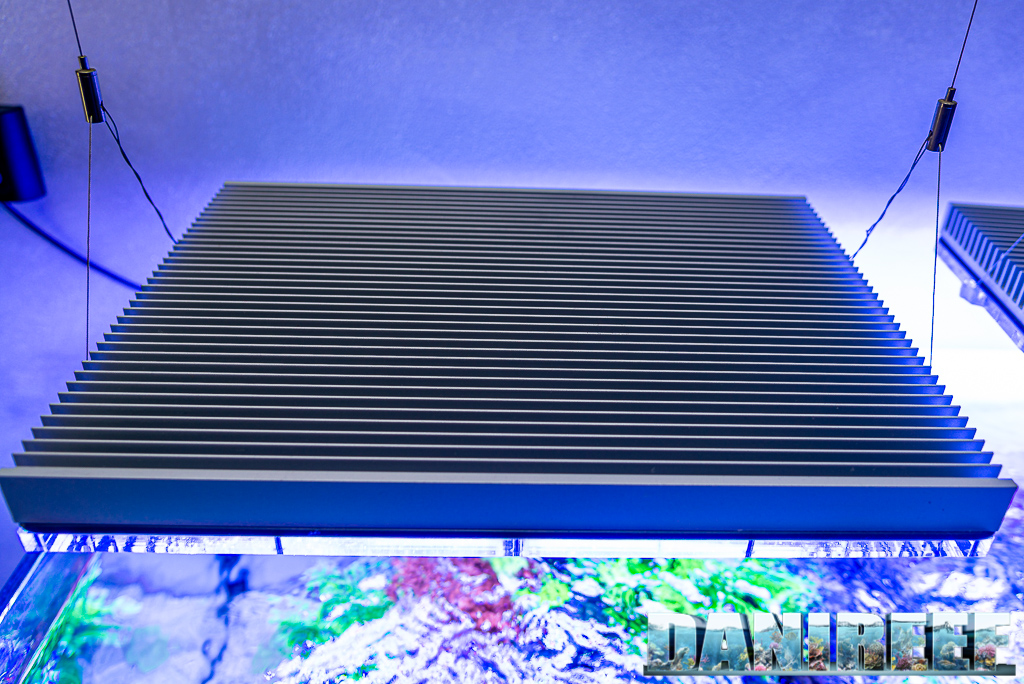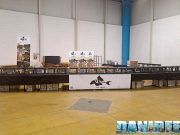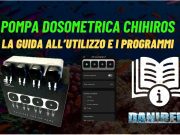How to value these numbers in aquarium?
This is a good question. At first we thought that we could transport these values to the aquarium tout-court. Than we filled the aquarium, insert the probe and redone the measurements. We fazed, but we’re going to talk about this in another article. Basically, while at 20 cm the result is practically the same, as we progressed, thanks to the glass reflecting the light and the same water, we found values bigger than the values measured in air. Obviously this isn’t a detail that can be standardized, so we think that our method of calculation is the most correct, and the best for the comparison of different ceiling lights.
Consumption
The measurement of the consumption was made possible thanks to the useful device RCE PM600 that can also measure the Cos(fi) (or power factor). The result is already given in watt.
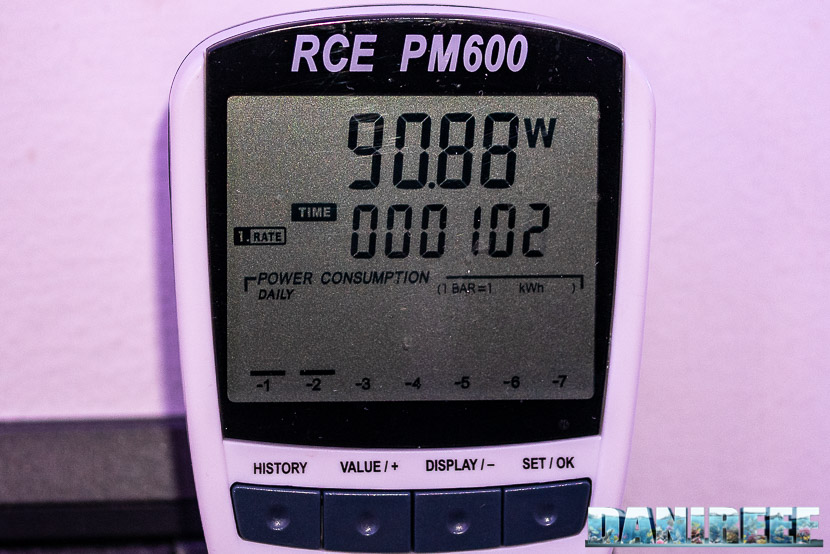
The calculus of the absorbed current, that is the power, is the following one:
Ceiling light Aqamai LRM: 90,88 watt. Considering that 17 cm the ceiling light has at the middle 2.285 μmol m-2 s-1, we can guess that it will have a peak value of 25,14 μmol m-2 s-1 w-1 (PAR per watt). A higher value that the Philips CoralCare’s one, due to the choice of distribution.
The value is lower than the declared one of 100 w. Maybe it depends also on the fan rotation speed.
The comparison with other ceiling lights on the market
Recently we started to use the new Apogee’s Quantum Meter MQ-510. For this we can’t completely compare the data of other ceiling lights because before we used the probe Seneye. The Aqamai LRM is the second ceiling light with which we adopt this method, so there will come many other comparisons in the next weeks. Actually, we’ve already measured the values of the Cetus 2 (preview – in italian) and the Aqamai LRS.
But considering these two first tested ceiling lights we can do an interesting comparison anyway.
| Energy | Price | Consumption | Energy/€ | Energy/w | |
| Aqamai LRM at 17 cm | 642.649 | 465 | 90,88 | 1.382 | 7.071 |
| Aqamai LRM at 37 cm | 721.676 | 465 | 90,88 | 1.552 | 7.941 |
| Aqamai LRM at 57 cm | 616.470 | 465 | 90,88 | 1.326 | 6.783 |
| Philips CoralCare at 17 cm | 1.858.572 | 749 | 190,50 | 2.481 | 9.756 |
| Philips CoralCare at 37 cm | 1.340.533 | 749 | 190,50 | 1.790 | 7.037 |
| Philips CoralCare at 57 cm | 933.246 | 749 | 190,50 | 1.246 | 4.899 |

The energy produced per watt is more constant in the Aqamai LRM rather than in the Philips. Same for the energy per watt when we progressively move away from the release point: it’s better with the Aqamai rather than the Philips, that having the LED on the external surface lose more on the sides. At 37 cm the values are pretty comparable, but we have to remember that the Philips have twice the costs and consumption, therefore they have higher values.
| Ceiling light | PAR | Watt | Price | PAR/watt | euro per watt |
| GNC 466 | 696 (Seneye) | 120 | 1.400 euro | 5,8 spread | 11,7 |
| Orphek Atlantik V4 | 1.515 (Apogee) | 226 | 1.099 euro | 6,7 spread | 4,9 |
| Philips CoralCare 2019 | 2.088 (Apogee) | 190 | 749 euro | 11 spread | 3,9 |
| Maxspect Ethereal | 689 (Seneye) | 130 | 500 euro | 5,3 semi-spread | 3,8 |
| Led Bars Askoll Pure Marine | 237 (Apogee) | 28 | n.d. | 8,4 | |
| Zetlight UFO ZE-8000 | 791 (Seneye) | 91,5 | 500 euro | 8,6 cluster | 5,5 |
| Aqamai LRM | 2.285 (Apogee) | 90,88 | 465 euro | 25,14 double cluster | 5,1 |
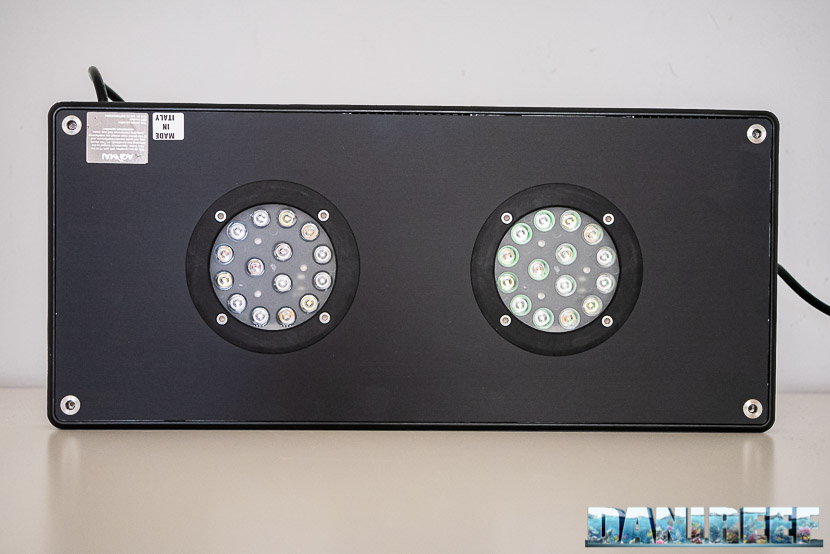
Devices in hand, Aqamai LRM has the highest value of peak PAR per watt ever passed in our hands. The euro per watt are in the average.
Mantaining costs
The Aqamai LRM ceiling lights costs 465 euro.
The absorbed power is 90,88 watt, so the relationship cost/watt is about 5,1 euro per watt. In order to do a comparison with the other ceiling lights you can refer to this chart:
| Ceiling light | Price | Consumption | Relationship euro per watt | |
| Philips Coralcare 2019 | 749 euro | 190 watt | 3,9 euro per watt | DaniReef LAB |
| Maxspect Ethereal | 500 euro | 126 watt | 4,0 euro per watt | Italian test |
| Radion XR30w G2 PRO | 790 euro | 170 watt | 4,7 euro per watt | Italian review |
| Radion XR30w G4 PRO | 915 euro | 190 watt | 4,8 euro per watt | Italian article |
| OceanLed Sunrise 600 | 870 euro | 180 watt | 4,8 euro per watt | Italian test |
| Orphek Atlantik V4 | 1099 euro | 226 watt | 4,9 euro per watt | Test |
| Radion XR30w G2 | 690 euro | 140 watt | 4,9 euro per watt | Italian review |
| Radion XR30w G4 | 760 euro | 150 watt | 5,1 euro per watt | Italian article |
| Aqamai LRM | 465 euro | 87,5 watt | 5,1 euro per watt | |
| Zetlight UFO ZE-8000 | 500 euro | 91,5 watt | 5,5 euro per watt | Test |
| CEAB Slide & Led | 2.700 euro | 275 watt | 9,8 euro per watt | Review |
| Sicce GNC 466 | 1.592 euro | 120 watt | 13,3 euro per watt | Italian review |
The ceiling light is very well built, easy to set, in particular if you want to use the preset programs. The PAR are very good especially in the middle and in terms of efficiency are perfect. Sure, they can’t compete with ceiling lights that consume twice as much, even if they have a perfect performance for their consumption. Perfect for demanding corals probably in an area of 30×30 cm, but anyway they consent to breed anything. It has a cost per watt relationship in the average and a record peak PAR per watt. What else we can ask for?
Questions and comments, as always, are welcomed. And most of all, do you like our measuring method?








